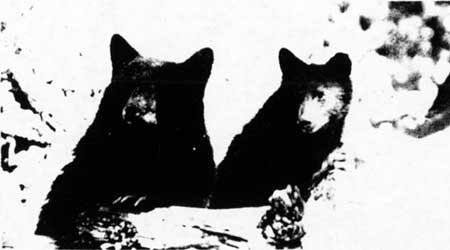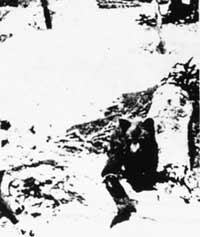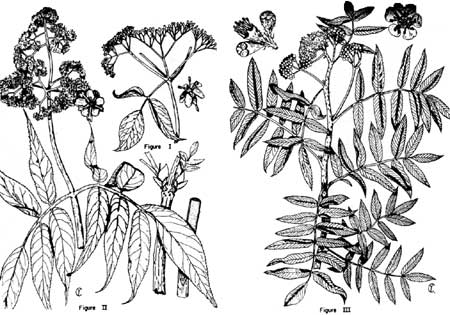|
Volume XIX - 1953
Crater Lake Discovery Centennial

Crater Lake Bears. From kodachrome by Welles and
Welles.
Observations And Census Of The Black Bear In Crater Lake National Park
By Roland D. Walters, Ranger Naturalist
The Olympic black bear, Euarctos americanus altifrontalis
(Elliot) was first noted at Crater Lake from the standpoint of numbers
in 1896 when a biological survey was made of the mammals in this area.
At that time the black bear was reported to be uncommon (Merriam, 1897).
According to one ranger naturalist, bears were so scarce at one time
that it was feared they would become extinct in this area. It seems,
however, that in 1919 hopes for their survival took a turn for the
better when a long, starved-looking female bear put in her appearance
(Wynd, 1930).
She soon gave birth to a pair of twins and, after rearing them to
the independent stage, wandered off one day to a nearby logging camp.
Having learned to place her confidence in human beings, she sat down by
a tent and waited to be fed--but instead of food she received a lead
slug. The twins, named Jemima and Buster, carried on successfully and
are said to be the forerunners of most of the bears now found in the
park.
The total number of bears observed in the fall of 1933 was fourteen.
This census was taken after the first heavy snowfall, at which time the
bears relied on food scraps obtained at the dining hall near park
headquarters (Canfield, 1933). According to Wallis (1947), Wildlife
Ranger Wilfred Frost observed forty-two bears on August 31, 1939.
Thirty-three were black, the remainder being of the brown color phase.
Wallis himself estimated the bear population in 1947 to be between
twenty and thirty in number. From the foregoing records it is evident
that the census of bears during the past 50 years is rather incomplete
and lacks data in regard to methods used, percentage of various color
phases and any breakdown into age groups.

Cinnamon Cub. From kodachrome by the author.
|
"Where can I find a bear?" "How many bears are there in the park?"
Questions such as these stimulated me to pursue an active program of
observations on the bears in the park. During the summer months of 1953
daily records were made in regard to size, color, number and habits.
Although the National Park Service long ago discontinued bear
feeding "shows" and prohibits the feeding, teasing and molesting of
bears, with the welfare of both bears and visitors in mind, the animals
are occasionally seen crossing the roads in various places in the park.
They frequently wander through the campgrounds looking for food that may
not have been packed away in a secure place. The bear is not a rare
mammal in Crater Lake National Park.
The following table is a record of the quantitative results
obtained. To obtain this data a segregation plan was used. First, the
several females and their first year cubs were segregated, the second
year cubs were then differentiated from medium and full size single
adults. Daily observations included many repeats which were hard to
distinguish at first but soon various differentiative characteristics
such as general size, obesity and sex became helpful in individuals
within a given category.
It should be understood that by no means do I consider this to be
complete because such a field census undoubtedly includes some
duplication, and some bears would go unobserved in an area covering two
hundred and fifty square miles. However, this is an attempt to start
filling in a gap that can be added to from time to time as better
methods and additional observations are employed.
| ADULTS |
| No. | Size | Color |
| 8 | Full grown | Black |
| 6 | Full grown | Brown |
| 4 | Medium size | Black |
| 4 | Medium size | Brown |
| 22 |
|
|
| CUBS |
| No. | Size | Color |
| 5 | First year | Black |
| 7 | First year | Brown |
| 1 | First year | Cinnamon |
| 3 | Second year | Black |
| 3 | Second year | Brown |
| 19 |
|
|
Total 41
The only record of a bear observed nursing her young in the park
prior to this year was made in 1939 by Mr. Frost (Wallis, 1947). He
observed a mother bear nursing triplets near one of the disposal areas.
Ranger Naturalist John Mees observed a mother nursing her twins in June,
1953 According to Mees, the mother bear assumed a prostrate position by
lying on her back; then with the help of her front paws the two young
were arranged in orderly fashion on her ventral side for nursing. Mr.
Mees observed them from a distance of fifty yards and noted that loud
gurgles could be heard that far away.
As can be seen in the table, which notes the number of bears
observed, there was apparently only one cinnamon cub for the 1953
season. This little cinnamon bear had a black twin which was
considerably larger. One day the mother crossed the road and, since the
snow banks were rather steep on either side, the cubs had to really
scramble to climb over them. In fact, the poor little cinnamon could
hardly make it up. He rested about half way up one bank and then made it
on the second attempt. Since he was not seen again during the season, I
wondered if some male bear had killed him.
Two of the full grown male bears, one black and one brown were very
conspicuous because of their unusually large and seemingly long front
legs. Several of the park staff noted this unusual anatomical feature.
The older males also have very large, hard-looking heads which one
cannot mistake in trying to segregate the groups.
References
Canfield, David H. 1933. A Bear Story. Nature Notes from Crater
Lake National Park 6(1):8-9.
Merriam, C. Hart 1897. The Mammals of Mount Mazama. Mazama
1(2): 204- 230.
Wallis, Orthello L. 1947. A Study of the Mammals of Crater Lake
National Park. Unpublished Master's thesis, Oregon State College,
Corvallis. 91 pp.
Wynd, F. Lyle 1930. Triplets. Nature Notes from Crater Lake
3(1):2-6.

Drawing by the author.
Three Similar Shrubs In Crater Lake National Park
By Charles F. Yocom, Ranger Naturalist, 1952.
Visitors in Crater Lake National Park during the latter part of the
summer frequently notice the attractive white blooms of certain green
shrubs along the Klamath Falls entrance road (south entrance) and along
the walks near the Information Building and the Lodge. Ranger
naturalists are occasionally asked the name of one of these plants but
from the description are usually unable to tell the visitor the exact
name of the plant, for there are three different kinds of shrubs in the
park that have somewhat similar appearing blooms and leaves. These are
blueberry elder, Sambucus coerulea (Fig. I), Pacific red elder,
Sambucus racemosa var. callicarpa. (Fig. II), and western
mountain ash, Sorbus sitchensis (Fig. III).
Two of these plants, the elderberries, are in the same genus and the
leaves and stems look nearly identical. They differ, however, in the
shapes of the flower clusters. The blueberry elder has a cluster of
flowers that appears somewhat similar in shape to an umbrella, whereas
the white flower clusters on the red elder are dome-shaped or somewhat
pyramid-shaped. If the branches of either are broken one can see that
the stems are filled with a soft substance called pith.
Mountain ash is related neither to the elderberries nor to the ash
tree, which it also resembles; but it is closely allied with the wild
rose, apple, peach, pear, plum, chokecherry and serviceberry, all of
which belong to the rose family. In some areas, mountain ash attains the
proportions of a small tree; in Crater Lake National Park, however, it
usually occurs as shrubs. The elders belong to the honey-suckle family
and should not be confused with alders.
For structural differences between the three shrubs, see the table
below. Blueberry elder occurs only along the south boundary of the park
and is common along the roadsides between Klamath Falls and Fort
Klamath. Mountain ash and red elder occur at higher elevations in the
park and often are growing side by side. All of these shrubs furnish an
important source of food for many birds and some mammals.
In late summer and fall visitors observe the attractive berries of
these shrubs along the roads and walks. There is no difficulty in
telling the two elders apart at this time of year, for they have berries
colored according to their common names. Of course, those with blue
berries (Sambucus coerulea) are found at lower elevations and are
often sought for pies and wine. Mountain ash and red elder have berries
that look somewhat alike, so one must look for differences in leaves and
stems.
Also remember that the cluster of berries of mountain ash is
somewhat umbrella-like in shape and that the berry cluster of red elder
is oblong, the berries themselves being brighter red.
Comparative Table of the Three Confusing Shrubs
| Character | Mountain Ash | Red Elder | Blueberry Elder |
|
| Color of flowers | white | white | white |
| Shape of flower cluster | umbrella-like | dome-shaped or pyramid | umbrella-like |
| No. of petals | 5 | 5 | 5 |
| No. of stamens | more than 5 | 5 | 5 |
| Color of berry | Orange-red | bright red | blue |
| Shape of berry clusters | flat topped cluster | oblong cluster | flat topped cluster |
| No. of leaflets | 9 to 11 | 3 to 9 | 3 to 9 |
| Color of leaflets | shiny green | dull green | dull green |
| Amount of pith in stem | very little | much | much |
| 
